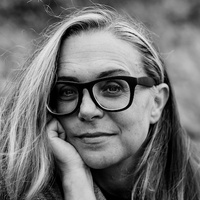On embracing your strengths and weaknesses
Prelude
Menno Pasveer is a painter based in The Hague, NL.
Conversation
On embracing your strengths and weaknesses
Artist Menno Pasveer discusses painting as a puzzle, combating loneliness, and why he's kept his day job.
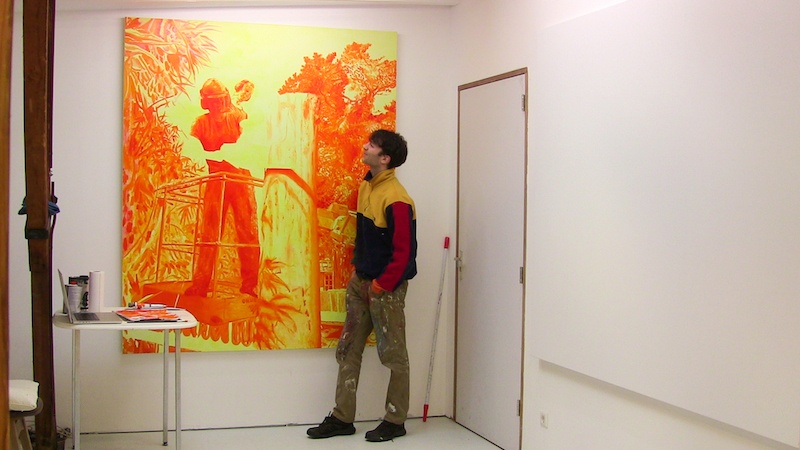
Menno in his studio with a couple paintings he’s working on. Photos by Tiana Dueck
How does a day in the studio begin?
The day starts with looking at the paintings, especially paintings I’m working on. Like 90% of the day of a painter is looking. Maybe 10% is actually applying the paint. Most of the time I’m just sitting here, I’m trying to understand the next step. So, almost every morning starts by just having a calm look at what I’m working on and seeing what’s next.
Are there ever days where you feel like you’re better at looking than others?
Definitely. Painting is more or less a puzzle. You’re trying to find a solution. Some days I see the solution, other days I really don’t.
It’s quite an obsessive thing for me. Especially now, bathing in one color with the series I’m working on currently. It almost keeps me awake at night… I’m already thinking, “Okay, that’s the next part.” I’m almost painting it in my mind. And then in the morning, I already know. On the bike, I’m already thinking about how I’ll structure a painting. So, it’s quite calculated.
Do you ever struggle to show up for your art practice with focus?
Being a painter is one of the most privileged professions that I can think of, and I find it extremely enjoyable. So there are few moments where I feel off about painting. There’s just an unending drive to improve.
I think the most beautiful painting will never be made. I’m always reflecting back on my last painting. I’m like, “Here is something I could do better.” Since the most beautiful painting will never exist, I’m always pushing myself to create it somehow. It’s an unending huge motivation. I’ll convince myself that some day I’ll finally paint the most beautiful painting. I think I can imagine the most beautiful things, I can really see them in my mind’s eye. But I can’t paint them. It’s just physically not yet possible in terms of technical aspects or whatever. But, the most beautiful painting exists in my mind.
What’s an aspect that you can’t get on the canvas, yet lives in your mind?
I think the biggest challenge has to do with light. I’m very obsessed with light. I think perhaps the essence of painting could be described as light. In the Renaissance or the Golden Age, the light came from a very white underpainting which made them appear very holy. You can almost feel an addiction to the painting as a viewer. For example, Peter Paul Rubens painted in nine layers. As a viewer of the painting, you are unable to replicate it in your mind. So that’s something that I’m really thinking and dreaming of… trying to replicate and advance that experience for a viewer.
Your process behind your An Ode to the Floor Cleaning Industry collection of paintings was personal and reflective. What draws you towards paying homage through your paintings?
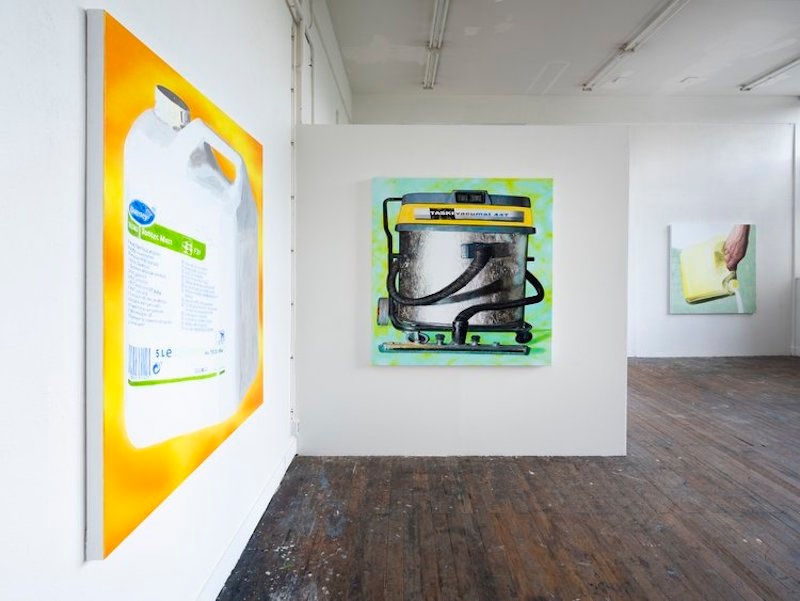
To put the cleaning industry on a pedestal was important for me because that job raised me in a way. My boss had raised me, in a way. I’m not sure if ironic is the right word, but I mean, painting this enormous dirty metal machine or vacuum, there’s a bit of humor and strangeness, which was also important in the series. There were six enormous chemical machines, painted like they were as dignified as royal horses! It’s a bit of a paradox.
The painting world can feel so serious in a lot of ways. So what does bringing humor into your work mean to you?
Having humor in my work is very important, especially while telling a story. I think every good story contains some humor. It draws you in, which is a big goal of mine with any painting, to make the duration of viewing as long as possible.
There’s something very relatable about humor too. If you’re a viewer who’s less in the painting and art world, you’ll probably have a more fun time looking at something that has something quirky about it. It holds the attention of a vast audience.
Yeah!
How does honesty influence your creative processes?
I really found out during my studies (at the Royal Academy of Art, The Hague) that honesty is one of the most important aspects in painting. It’s easy to read. Just like with an actual conversation, you can feel if someone is being honest. It’s the first thing you can feel, If someone means something.
At the academy, in the beginning, I was influenced by the pressures of art history and my surroundings. I wanted to comment on huge topics. I started making creative work about war and, well, I have nothing to do with war! Then slowly, I drew from personal narratives. Like through the floor cleaning industry, which is so close to me that it couldn’t come across more honestly. From there, the rest came naturally.
How do you balance making a living with an authentic art practice?
That’s sometimes a bit complicated. I work one day a week and every holiday still, as a floor cleaner, to make my stable living. I’ve been blessed to be able to support my practice through painting sales. I work five or six days a week as a painter here in my studio. I’m still figuring out how that works. So far it’s going well. I can live for my paintings, and that feels really amazing.
With working five, six days a week as a painter, do any anxieties about making a living ever get in the way of your creativity?
Anxiety regarding making a living? I don’t really have that, because I just love working. Like, if it doesn’t work regarding painting, then I really don’t mind working anywhere else. I take much joy from cleaning floors. I would like to be a carpenter. There are many jobs that I would like to do, so I really don’t mind working one or two days a week in another occupation.
You recently worked with the painter Philip Ackerman as an assistant. How was it to work under another artist?
That was amazing for me. Philip Ackerman is one of my biggest idols, and a real example for painters. Regarding painting, he’s one of my heroes. I wrote my thesis about him.
Being a painter’s assistant was very new for me because you almost have to method act. I really tried to become him. We were listening to his type of music. I tried to mimic his hands, and his signature quirks while painting. So, trying to think and act like someone else within painting was super interesting for me.
There is a lot of looking inward with painting. Like, at an opening or exhibition, or when people visit my studio, it’s all about my personal art practice. So, it was very liberating to work underneath someone. Assisting him, learning new techniques from him…focusing on someone else’s practice.
I look up to him. So at first, I was so nervous I could barely sleep. If I mess up in my own practice, then I just mess up my own work, and it’s fine. We were painting a mural, which doesn’t really allow for undoing mistakes. Ackerman told me, “If we make a mistake, we will show it.” Whereas for me, I think I usually try to cover up my mistakes.
Did you learn anything about mistakes through him?
For example, in a painting I’m working on now, I made a huge key mistake in the beginning. The sketch is far too harsh, and it’s now visible throughout the whole painting. If you get close, you can see the pencil marks everywhere. I think I enjoy it more when it’s just a smooth painting surface. But with this, I’m like, you know what? It’s okay. It’s all right. I’m just gonna leave it. Maybe those mistakes will emphasize the cleanness of the painting over it.
How has your practice changed since graduating?
It’s a bit more focused now. I mean, we were in a huge shared studio. The academy is quite studio focused. From the second year, you get a studio, and you have no assignments anymore. The teachers will follow you in your process. So if you are very interested in minimalism, they will address some minimalist artists and try to help you with that. But in a way, my routine has just continued. I was painting six days a week in my studio at the academy, and now six days a week here.
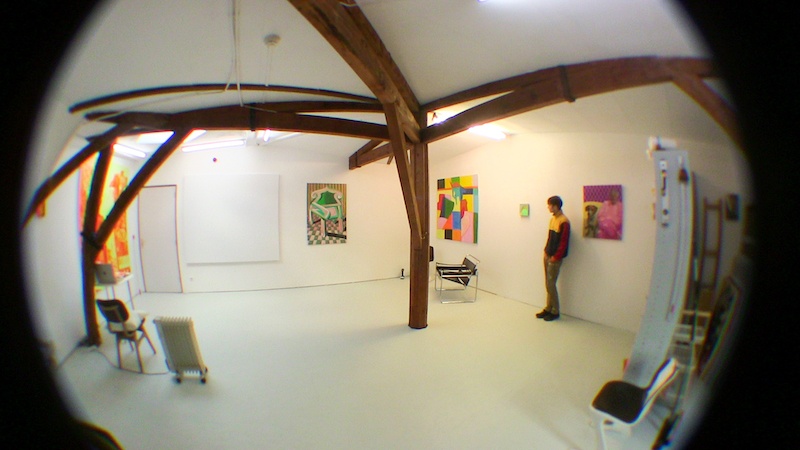
It seems like a nice transition then. What was art school like for you?
It was an incredible time for me. Now, I’m alone in the studio. There, I was with many others, which was fun. It was nice that you could speak with people. One of my fears of the painting profession is that it is a very lonely profession. It’s quite an obsessive practice. I’m always here. If I don’t watch out, I won’t meet with friends or do things apart from painting.
What do you do about that loneliness, if anything?
In all honesty, it’s been a bit of a struggle. I’m here from early in the morning until around dinner. Then I go home, that’s just been a bit difficult. I’m trying to do some things apart from my studio time. I just need to do some things with others, like playing football. But I’m also considering inviting a second artist in the studio since it’s so big.
One big plus from this studio is that I can connect with the other artists renting here when I go downstairs. That’s really how I tackle the loneliness. I just go downstairs to play chess or have a chat with my colleagues.
At the same time, there are two sides to the coin. I’m like the king of my studio. It’s so nice being in the studio by myself, listening to my own music, being in my own world.
Before choosing to pursue art as a career, did you ever have any initial hesitations?
Actually, while studying at the academy, quite often I considered quitting. At the academy, everything was so new. The world seemed so big. I had doubts about the art world, me fitting in… if I could add anything to this art world.
What am I to say? I have nothing to say. I’m not a philosophical thinker. I’m not a writer. I don’t have much history knowledge. I think the misconception was that I thought I had to say something important as an artist, and that was my biggest struggle. At some point, there was this switch that you can also focus on the formal qualities of a painting, convincing someone not by what you say, but by how you say it. I can convince people by how I paint, rather than trying to form a huge, important story about war or something. After that, for two years I did paintings of chairs. They had nothing to say. They were chairs. They were just aesthetically convincing artworks. That was key for me.
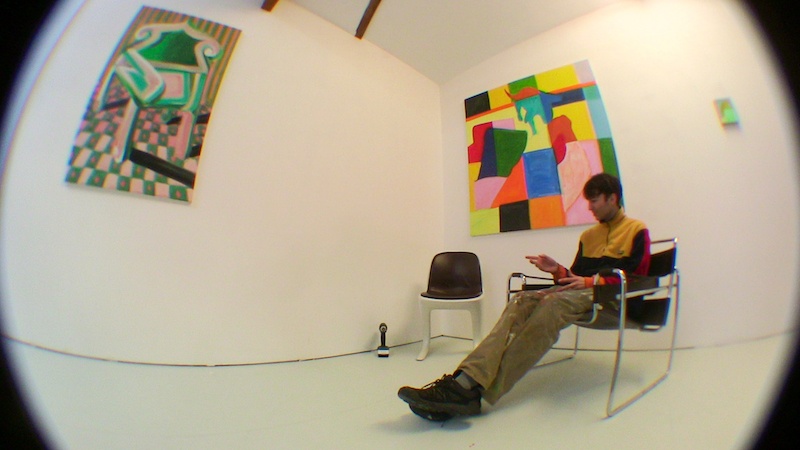
I resonate with that. What role might friendship play in your art practices? Do you ever feel influenced by your friends?
Yes, very much. There are a couple friends of mine who are enormous motivations for me. Looking back on what I said about motivation, to aim for this holy painting, the highest goal; I believe some of them are sometimes a bit closer to what I think that painting must be.
There’s also a sense of competition within painting, which is sometimes difficult. Yet, it’s also very fun. If some of my friends do very well and they have a nice exhibition, they motivate me to push even more. They’re huge inspirations.
Have there been any anxieties throughout working on a new series so far?
There’s always an anxiety if it will work out. Before painting, I have no idea what will actually come out.
While graduating, I was sure of an exhibition and people seeing the work, but now that’s not as certain. Although for this series, I am. I’m very close to confirming an exhibition in Amsterdam or New York. So I’m really putting everything in this.
Perhaps this will not be perceived the same as my graduation work. I’m not sure if people want to continue to see the style I had then, or if they want to see something new. But, not knowing if my work will be shown can be a bit scary.
If my paintings just stay in my studio, they’re not dead, but they’re just… here, probably hidden in the closet. But if they are exhibited somewhere, they’re alive and they communicate. That’s really what I want and hope for.
Once it’s on view, it’s the most aligned with its function. The function of paintings is to communicate. Right now, it’s only communicating with me, and now with you.
When a painting is sold, then you have a direct influence on someone’s daily life. Which is an incredible opportunity. Like with architecture, as an architect, every day you are influencing someone’s life by the size of the room and its atmosphere. With painting, for example, if you have an enormous orange painting in your house, it’s very different from a small blue one. It has a completely different impact on a space.

Right. This orange painting is very energetic! How does your respect and adoration for things around you show up in your art practice? And in reverse, how does your art influence your perspective on life?
Most definitely. It’s an incredible experience. For example, I did a painting of my father.

Menno beside a painting of his father and dog.
To spend months being so close to my father in this instance, or machines in my previous collection, you completely perceive a being or object in all its details. As a painter, I can see beauty in small objects because I can see painterly values in them like light or shape. In that way, through painting, my perception of the world has changed forever.
If I see something beautiful, my mind immediately transforms it into a painting. So, my life shows up in my work. I think it comes back to honesty. The things that I paint are also in my daily life. Like my father, those machines, his chairs, or my garden.
Looking at this orange painting of yours, I like how every now and then an element is left out, like part of an arm. There’s intentional empty spaces in your work. What does leaving some things to the mind’s eye mean to you?

Very much, especially those empty spaces. Even though this is a figurative painting, you can completely approach it as an abstract piece. Obviously there is a figure and there is a machine and there is a tree, but there are abstract values within the painting.
Those empty spaces are an aesthetic compositional choice that leave a lot of room for the viewer to fill in the gaps, and they lengthen the viewing time. If you leave that room for interpretation to the viewer, they feel much more connected to the painting.
I find it incredible that as a painter I can convince a viewer and direct their gaze. I find it all extremely exciting and motivating.
Menno Pasveer Recommends:
The book Vitamine P3, “new perspectives in painting,” a book filled with over 100 painters who are engaging with—and pushing the boundaries of—the medium of paint.
Painters to have a look at: Philip Akkerman, Konrad Klapheck, Sasha Gordon, Simphiwe Ndzube, Issy Wood, Luc Tuymans, Stanley Whitney, Willem de Kooning.
- Name
- Menno Pasveer
- Vocation
- painter
Some Things
Pagination

